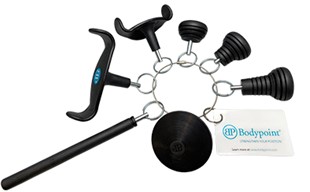My most influential mentor once told me that the only pre-requisite for independent mobility is the motivation to move, a statement I have often reflected on and referred to throughout my career. There may be learning or training requirements to reach successful outcomes and specialised set up and inputs may be required but often the only way to determine if someone could use assistive technologies to enable independent mobility is by giving it a go!

Pre-conceived Ideology
We need to consider our own ideology and views and how these impact our decision-making processes around independent mobility. Society can perpetuate stigma and without us having successful experiences to draw on, these ideologies can influence our understanding of capacity. If someone is in an aged care facility, do we still consider independent power wheelchair access? Or is there an assumed capacity that someone will not have the cognitive ability to learn to safely operate a powered mobility option?
I am yet to find a cognitive assessment that definitively correlates to a person’s capacity for independent mobility. Do we consider that the resident may not want to spend the afternoon watching TV, that maybe they want to participate in other activities but require appropriate postural support to functionally engage?
It is not uncommon for an assessment intended to identify areas that require training for independent mobility are used to rule out independent mobility for an individual rather than to then provide areas to focus on for said training. Is this due to safety, to lack of time and resources? What level of clinical reasoning has been used in determining if the individual will be safe? Has the least restrictive option to independent mobility been considered if there are safety concerns?
There are also similar barriers for young children. Whilst we know from human development that children start to ambulate at around the age of 12 months, are we providing similar mobility opportunities to children of this age with mobility impairments? What about our children who are unable to verbalise a goal or desire for independent mobility, or present with challenging reflexes or limited active motor movement, do we consider ways they can be successful, have we provided opportunities to give it a go?
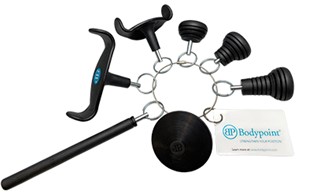
Joystick Access
There are many advantages to a joystick, the proportional function enables acceleration and directional control. A joystick is the standard access input for a powered mobility base and should be our first consideration for enabling independent control. Just because someone experiences some movement impairment in their upper limb doesn’t mean they will not have capacity to access using a joystick, however we may find that we need to modify the position, the location or the joystick knob.
We can also use the electronic programming to modify things such as the sensitivity, the acceleration or how far we need to deflect the joystick to action movement.
Position and Location
The mounting hardware that interfaces the joystick to the chair should have sufficient adjustment to enable it to be positioned further forward or back to enable us to adjust to the users’ individual requirements. You may also need to consider the arm support required in relation to the joystick position. A full-length arm rest may provide additional support but will limit how far back towards the user the controller can be positioned.
The height also needs to be considered, does the hardware enable fine tuning adjustment to raise or lower the control unit for best access to the joystick?
Non-standard mounting may be required to meet a user’s functional requirements. Midline controller mounting often provides better access and outcomes for developing children, the foot or chin may provide best access. Once you have identified how and where a user will access the joystick you can discuss options with your local product specialist.
Consider the user’s upper limb function, both gross motor and fine motor movements need to be considered, as too does strength and grip capacity.
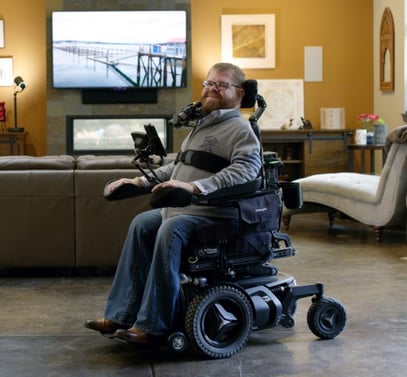
Controller and Joystick
When considering a powered mobility device, we also need to consider the capacity and configuration of the input device, whilst there are many similarities between different manufacturers, there are also differences. What may work for one user may not work for another.
Consider visually – can the user see what they need to see or sometimes it’s around “hiding” or reducing what can be seen to reduce sensory overload.
Can the user access any buttons or switches, can we program in shortcuts or memory functions to make access easier? What hand function does the user have and is the joystick knob matching these individual needs? I was privileged to be invited to an event some years back with Ability Mate coined a toggle-a-thon. Essentially, this was a day where power wheelchair users who were struggling to operate their chair due to controller access came along and met with a designer. Together, they identified what issues they had and came up with a plasticine prototype. This was then assessed in relation to the users’ clinical requirements before a 3D joystick was printed!
This was then trialled and, if required, the design was tweaked and re-printed. It was a great example of a collaborative approach driven by the end user’s needs and the use of 3D printing for users who could utilise a standard controller with modified joystick. I have also used splinting material to mould a hand support and purchased small balls for gross hand grip in those rare cases where an off-the-shelf joystick knob has not quite met the specific required needs.
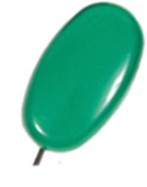
Switch Control
The advantages of a proportional control input method may be out weighted by fatigue of sustaining the deflection of the joystick or an individual may not have the required strength. It is important to consider both the type of joystick and the potential programming options in the first instance, but for some users switch control may provide the access required.
Proximity switches tend to require less movement to activate and are an important consideration when identifying switch access. The most common proximity switch control is through the use of a head array and this can be an advantageous method to consider for a child starting out with switch-controlled mobility. With the child turning their head towards the direction intended to move, the switch located in the head mounted pads activates.
With switch control, programming is also crucial. Switches can be latched or non-latched – think about a light switch, once you turn the switch on it remains on until you turn the switch off versus the switch only operational whilst you hold the switch down and sustain pressure on it. The switch hardware also differs with the amount of pressure required to activate.
As a therapist it is important to understand the user’s functional capacity to access and draw on your experiences or have an experienced therapist involved. Even working within a specialised seating service there are only a small proportion of wheelchair users that require complex alternative control set up so it is advantageous to work closely with a supplier or manufacturer experienced in setting up and programming the device.
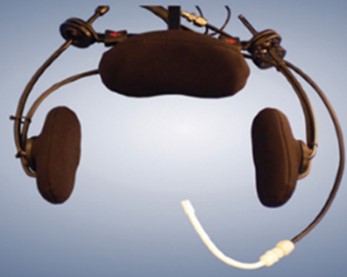
When considering access to independent mobility, it’s often about giving someone an opportunity to trial and working through the process. For further information or to discuss a potential alternative input method for powered mobility, you can always reach out to our team at education.au@permobil.com where we can discuss some of the considerations and assist you with setting up a trial with one of our product specialists.

Tracee-Lee Maginnity
Clinical Services Specialist
Permobil APAC
Tracee-Lee Maginnity joined Permobil Australia in July 2019, as a clinical education specialist. Originally from New Zealand, she graduated Auckland University of Technology with a BHSc (Occupational Therapy) in 2003 and has since worked in various roles related to seating and mobility including assessing, prescribing and educating. After gaining experience as an assessor and prescriber at Seating To Go / Wheelchair Solutions in prescribing for both disability and injury, she moved to Australia in 2011 to take on the Senior Occupational Therapist role in a custom moulded seating service. She then worked in clinical consulting and education roles until joining Permobil.
Tracee-Lee is passionate about maximising functional outcomes with end users and the importance of education within the industry. She has mentored many therapists interested in AT. Her experience includes working with complex postures to achieve custom outcomes. Tracee-Lee is also an international wheelchair rugby classifier where she enjoys the task analysis of wheelchair propulsion and functional capacity identification of athletes.
